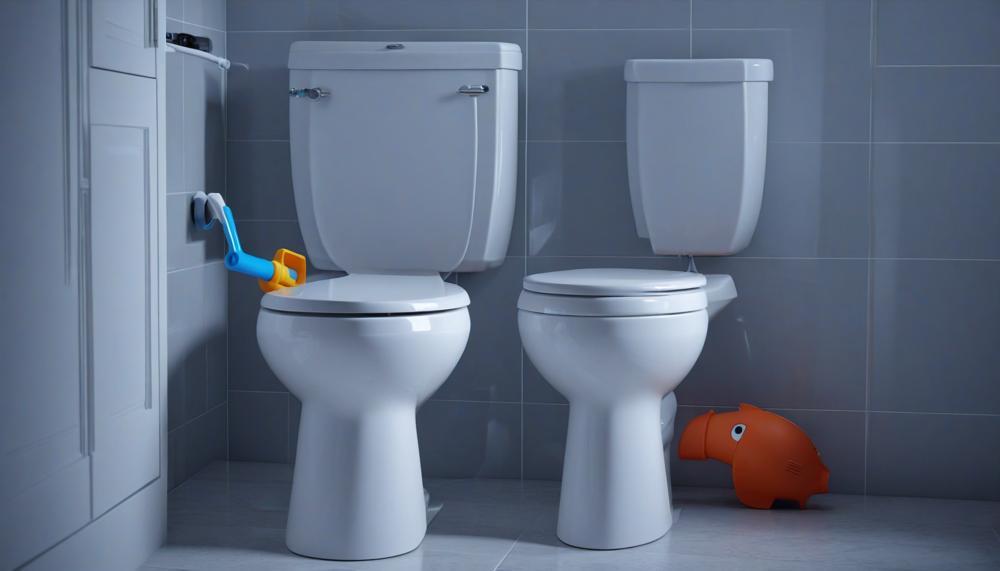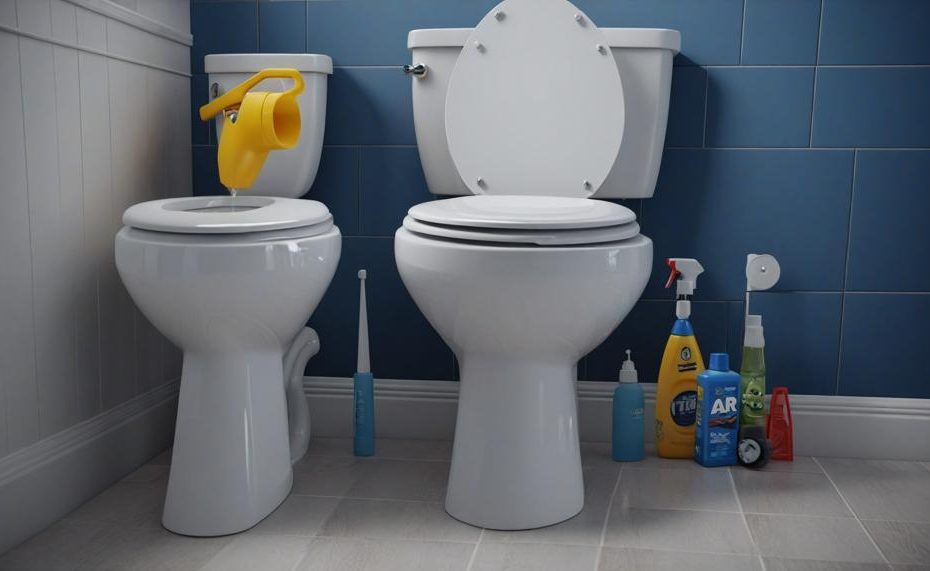Yes, you can clean caulk around your toilet effectively with the right approach and materials. Keeping the caulk around your toilet clean is essential for maintaining a sanitary bathroom environment and preventing the growth of mold and mildew.
If you’ve ever noticed discolored or grimy caulk, you’re not alone, and cleaning it doesn’t have to be a chore. With a few household items and a bit of elbow grease, you can restore that fresh, clean look to your bathroom.
Here are some key takeaways to get you started:
- Prevent Bacteria and Mold: Regular cleaning helps to stop the buildup of bacteria, mold, and mildew, keeping your bathroom hygienic.
- Simple Cleaning Solution: Use a mixture of vinegar and baking soda to effectively clean the caulk.
- Tackle Tough Stains: For more stubborn stains, create a paste with baking soda and vinegar.
- Disinfect with Rubbing Alcohol: Rubbing alcohol is a powerful disinfectant and can be used for a deeper clean.
- Regular Maintenance: Keep the area clean with regular upkeep to prevent discoloration and damage.
By following these simple tips, you can keep the caulk around your toilet looking pristine and ensure a healthier bathroom environment. Ready to dive into the details? Let’s get started.
Contents [show]
Applying New Caulk
Properly applying new caulk around a toilet involves a series of detailed steps. This process is essential to maintain a clean and fresh appearance, and to prevent unpleasant odors. Here’s a step-by-step guide to ensure a professional finish:
| Step | Description | Tools and Tips |
| 1 | Remove Old Caulk | Use a utility knife to carefully scrape away any existing caulk. Ensure all residue is removed for a clean surface. |
| 2 | Clean the Area | Thoroughly clean the base of the toilet and the surrounding floor area. Use a mixture of vinegar and baking soda, or rubbing alcohol to disinfect and remove any grime. |
| 3 | Apply Masking Tape | Place masking tape on the floor around the toilet’s base. This helps create a straight, even seal and protects your floor from excess caulk. |
| 4 | Prepare the Caulk Gun | Load your silicone caulk into the application gun. Cut the tip of the caulk tube at a 45-degree angle for a smoother application. |
| 5 | Apply New Caulk | Hold the caulk gun at a 45-degree angle and apply a steady bead of caulk around the toilet base. Ensure an even flow to avoid gaps. |
| 6 | Smooth the Caulk | Using your finger or a caulk smoothing tool, gently smooth the bead of caulk. This helps to push the caulk into the joint and creates a neat finish. |
| 7 | Remove Masking Tape | Carefully peel off the masking tape before the caulk dries. This ensures a clean, professional-looking edge. |
| 8 | Allow to Dry | Let the caulk cure according to the manufacturer’s instructions, usually 24 hours. Avoid using the toilet during this period. |
Tips for Success
- Choose the Right Caulk: Use 100% silicone caulk, which is more durable and water-resistant.
- Maintain Cleanliness: Regularly clean around the caulked area to prevent mold and mildew buildup. A solution of vinegar and baking soda can help keep it spotless.
- Safety First: Always ensure proper ventilation when working with caulk and cleaning agents.
Smoothing Out Caulk
Achieving a smooth finish when applying caulk around a toilet involves several key steps. Follow these tips for a flawless result:
Surface Preparation
Ensure the area around the toilet is thoroughly cleaned and dried. Remove any dirt, dust, and old caulk.
A clean surface is essential for the caulk to adhere properly.
Using Tape
Apply painter’s tape on either side of the joint where you plan to caulk. This helps in creating a straight, clean edge.
Make sure the tape is pressed down firmly to avoid caulk seeping underneath.
Applying the Caulk
Cut the tip of the caulk tube at a 45-degree angle. The size of the opening should match the width of the gap you are filling.
Hold the caulk gun at a consistent angle and apply steady pressure to dispense the caulk. Move the gun smoothly along the joint.
Smoothing the Caulk
Immediately after applying the caulk, use a caulk smoothing tool or a wet finger to smooth out the bead. This step should be done in one continuous motion to avoid bumps and ridges.
Wear disposable nitrile gloves to keep your hands clean.
Removing Excess Caulk
Wipe away any excess caulk with a damp paper towel before it dries. Clean the smoothing tool or your finger frequently to maintain a smooth finish.
Removing the Tape
Carefully remove the painter’s tape while the caulk is still wet. This prevents the edges from being pulled up and ensures a crisp line.
Drying And Cleaning Excess Caulk
Drying and cleaning excess caulk around a toilet can be a meticulous task but can be easily managed with the right approach. Here are the most effective techniques:
Drying Techniques
- Ventilation: Ensure the bathroom is well-ventilated. Open windows and doors, or use fans to enhance air circulation. Proper ventilation speeds up the drying process by reducing moisture in the air.
- Dehumidifiers: Utilise a dehumidifier to absorb moisture from the environment, significantly cutting down drying time.
- Cure Time: Allow the caulk to cure according to the manufacturer’s instructions. Most silicone caulks need 24 hours to fully set.
Cleaning Techniques
- Initial Cleaning: Wipe off excess caulk immediately after application using a damp cloth or paper towel. Be careful to avoid smearing.
- Vinegar and Baking Soda Solution: Mix equal parts of vinegar and baking soda to form a paste. Apply this paste to the caulk and scrub gently with a soft brush to remove grime and residue.
- Razor Blade or Caulk Remover Tool: For dried excess caulk, use a razor blade or a caulk remover tool to carefully scrape away excess material. This should be done gently to avoid damaging surrounding surfaces.
- Rinse and Dry: After scrubbing, rinse the area with warm water and dry thoroughly with a clean cloth to prevent mildew.
Proper Disposal Of Caulk Tubes
Proper disposal of caulk tubes is essential to minimise environmental impact. Follow these steps to ensure responsible handling:
| Step | Action | Details |
| 1 | Check Manufacturer Instructions | Read the label for disposal guidelines. |
| 2 | Empty Tubes | Dispose of in regular trash if completely empty and sealed. |
| 3 | Partially Full Tubes | Handle as hazardous waste; do not throw in regular trash. |
| 4 | Local Waste Management | Contact local facility for disposal guidelines. |
| 5 | Hazardous Waste Collection | Use designated facilities or collection events. |
| 6 | Recycling Options | Recycle if clean and accepted locally. |
| 7 | Minimise Environmental Impact | Follow guidelines to reduce harm to the environment. |
Cleaning Caulk Without Removal
For effective cleaning of caulk around a toilet without removal, follow these methods:
| Method | Ingredients | Steps |
| Vinegar and Baking Soda | Vinegar, Baking Soda | Apply paste, wait 10-15 minutes, scrub, rinse, dry |
| Hydrogen Peroxide and Baking Soda | Hydrogen Peroxide, Baking Soda | Apply paste, wait 5-10 minutes, scrub, rinse, dry |
| Bleach Solution | Bleach, Water | Spray solution, wait a few minutes, scrub, rinse, dry |
| Commercial Caulk Cleaners | Commercial Cleaner | Follow product instructions, rinse, dry |
Using these methods, you can maintain clean and hygienic caulk around your toilet without the hassle of removal.
Maintaining And Preventing Caulk Damage
To maintain and prevent caulk damage around a toilet, it’s crucial to replace the caulk every two to five years. This interval can vary depending on several factors such as the frequency of use, the type of caulk used, and the bathroom’s humidity levels.
Regular inspection for wear, damage, or mold growth can help determine if the caulk needs to be replaced sooner.
Factors Influencing Caulk Replacement Frequency
| Factor | Description | Impact on Replacement Frequency |
| Frequency of Use | Bathrooms with high usage see more stress on the caulk. | High usage requires more frequent replacement. |
| Type of Caulk | Silicone caulk tends to last longer than acrylic latex caulk. | Silicone: up to 5 years; Acrylic: around 2-3 years. |
| Humidity Levels | High humidity can lead to mold growth and quicker deterioration. | High humidity areas may need replacement every 2-3 years. |
| Cleaning Methods | Harsh chemicals can degrade caulk faster. | Gentle cleaning extends caulk life; harsh cleaning shortens it. |
Maintenance Tips
- Regular Inspections: Check the caulk every six months for signs of cracking, peeling, or mold.
- Proper Cleaning: Use mild cleaners like vinegar and baking soda to avoid damaging the caulk.
- Prompt Repairs: Address any visible damage immediately to prevent water leaks and further damage.

Conclusion
Keeping the caulk around your toilet spotless is simpler than you might think. Regular maintenance not only enhances the appearance of your bathroom but also prevents the growth of bacteria and mold, ensuring a hygienic environment. Here’s a quick recap of how to keep your toilet caulk clean and fresh.
To start, the key is regular cleaning. A mixture of vinegar and baking soda works wonders for everyday cleaning, effectively tackling grime without harsh chemicals. For tougher stains, a baking soda and vinegar paste applied directly to the caulk can help lift deep-seated dirt. Don’t forget the power of rubbing alcohol for disinfecting and removing any residual stains.
If your caulk is beyond cleaning, applying new caulk is a straightforward process that ensures a professional finish. Begin by removing the old caulk with a utility knife and thoroughly cleaning the area. Apply masking tape around the toilet base to achieve a neat line. When you’re ready to apply the new caulk, use a caulk gun at a 45-degree angle for a smooth bead, and immediately smooth it with a caulk tool or a wet finger. Finally, remove the tape while the caulk is still wet and allow it to cure for 24 hours.
Remember, choosing the right caulk is essential—opt for 100% silicone for durability and water resistance.





